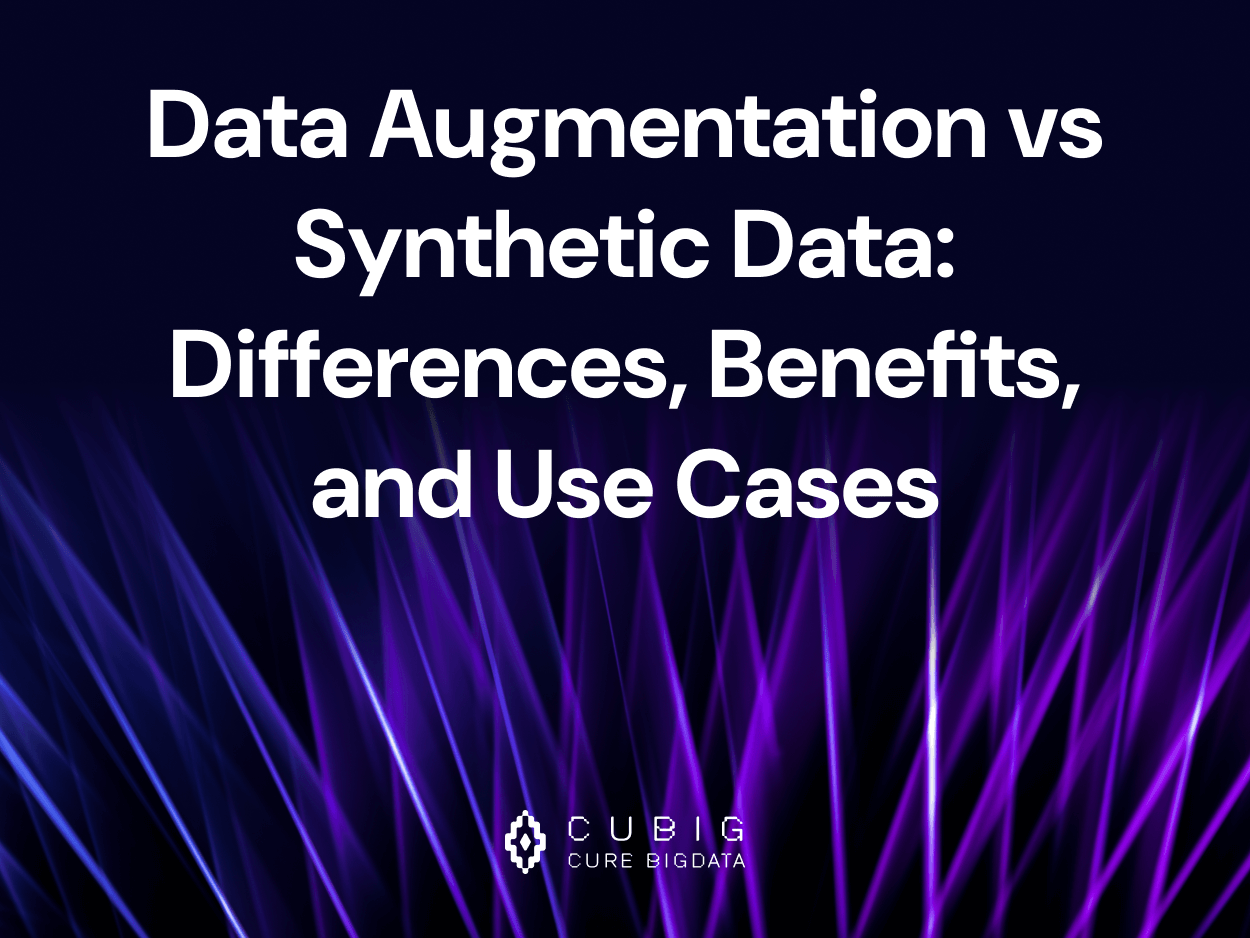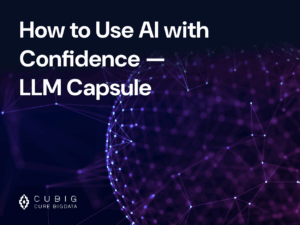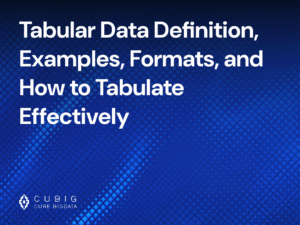Data Augmentation vs Synthetic Data: Differences, Benefits, and Use Cases
Table of Contents
What Is Data Augmentation?
Definition and Purpose in Machine Learning
Data augmentation is a technique used to artificially increase the size and diversity of a dataset by applying a variety of transformations to existing data. Its main purpose is to improve the generalization capabilities of machine learning models, especially when the available training data is limited. By introducing controlled variations, data augmentation helps prevent overfitting—where a model performs well on training data but poorly on new, unseen data—by exposing the model to more diverse input patterns during training.
Common Techniques: Rotation, Cropping, Noise Injection
In computer vision, common augmentation techniques include rotating, flipping, scaling, translating, and cropping images, or adjusting brightness and contrast. In natural language processing (NLP), augmentation may involve replacing words with synonyms, paraphrasing sentences, or randomly masking tokens. In audio and speech processing, noise injection, time stretching, pitch shifting, or adding background sounds are often used. These transformations preserve the semantic label of the original input while introducing diversity that helps the model learn more robust features.
Use Cases: Image, Text, and Audio Domains
Data augmentation is widely used across different domains: – In image classification and object detection, augmented images help models recognize objects from different angles or lighting conditions. – In text classification tasks like sentiment analysis or intent recognition, textual data is augmented to handle varied expressions or typos. – In speech recognition or voice command models, variations in pitch, background noise, or accent are simulated to reflect real-world usage. Overall, data augmentation is a lightweight, effective strategy to improve performance without collecting new data.
What Is Synthetic Data?
Definition and Concept of Fully Generated Data
Synthetic data refers to data that is completely generated by algorithms rather than derived from any real-world samples. It is created to mimic the statistical patterns and structural features of real data, often using technologies such as generative adversarial networks (GANs), simulators, or transformer-based models. Unlike augmentation, which modifies existing data, synthetic data can generate entirely new instances from scratch, providing broader coverage of the data space.
How It Differs from Augmented Real Data
While both techniques aim to enhance datasets for model training, they differ fundamentally in origin and scope. Data augmentation depends on existing, labeled data and applies modifications to it. In contrast, synthetic data can be created without any original input—allowing generation of data for underrepresented scenarios or where real data is scarce. Synthetic data can include combinations never seen in the original dataset and is not bound by privacy or ownership issues, making it ideal for training in regulated environments or for testing edge cases.
Use Cases: Privacy, Simulation, Rare Events
Synthetic data is particularly valuable in situations where data privacy is a concern, such as in healthcare or finance, where regulations like HIPAA or GDPR limit the use of real personal data. It enables: – Training models on representative but non-identifiable data. – Simulating rare or high-risk scenarios like fraud, system failure, or medical anomalies. – Generating balanced datasets where certain classes or outcomes are underrepresented. It also supports the development of AI models in early-stage projects where real data has yet to be collected, or in testing environments where safety and compliance are critical.
Data Augmentation vs Synthetic Data: A Side-by-Side Comparison
Source Dependence: Derived vs Generated
Data augmentation operates by applying controlled transformations—such as cropping, flipping, noise injection, or synonym replacement—to real data. These transformations retain the structure and semantics of the original inputs. Synthetic data, on the other hand, is generated independently of real samples. Using techniques like GANs, simulators, or language models, synthetic data can be created entirely from rules, distributions, or prompts—enabling dataset creation even when no real data is available.
Control Over Labeling and Scenarios
In data augmentation, labels are inherited directly from the original data. For example, rotating an image of a cat doesn’t change the fact that it’s still a cat. This makes augmentation fast and label-efficient. Synthetic data provides full control over label creation. You can generate perfectly balanced classes, simulate rare edge cases, or even create novel combinations not present in original datasets. This makes synthetic data highly customizable for training underrepresented or high-risk scenarios.
Scalability and Resource Requirements
Augmentation is typically lightweight and can be done in real-time during model training, using minimal resources. It’s especially efficient when added as part of a data pipeline in image or text tasks. Synthetic data generation is more resource-intensive. It often requires model training (e.g., for GANs), simulation environments, or prompt engineering in large language models. While scalable in output volume, it also demands significant computational and validation effort.
Suitability for Different ML Pipelines
Data augmentation is ideal when you already have a sizable labeled dataset but want to improve robustness and generalization. It works best when data variability can be simulated with minor changes. Synthetic data fits pipelines where real data is limited, highly sensitive, or biased. It’s especially valuable in privacy-critical industries, early-stage ML development, or use cases involving rare events that are difficult to capture in real life.
When to Use Data Augmentation vs Synthetic Data
Project Goal: Expansion vs Simulation
If your goal is to expand existing datasets and improve model generalization to unseen but related data, choose augmentation. This is common in tasks like image recognition, sentiment analysis, or speech processing. If your goal is to simulate realistic scenarios or train on patterns not present in your current data—such as simulating financial fraud or medical anomalies—synthetic data provides the flexibility and scale to do so.
Available Data Quantity and Quality
When you have a robust, labeled dataset, data augmentation is a cost-effective and quick method to boost performance. It enhances existing examples without needing new data collection. However, when your dataset is sparse, biased, or contains sensitive personal information, synthetic data helps create training material while protecting privacy and avoiding compliance risks.
Regulatory or Privacy Requirements
In regulated industries like healthcare, finance, or government services, real data often comes with usage restrictions. Data augmentation cannot remove the risk of re-identification, as it is still derived from real individuals or transactions. Synthetic data—when properly generated and validated—can serve as a privacy-preserving alternative. It enables model development, testing, and sharing in compliance with regulations like GDPR, HIPAA, or CPRA.
Budget and Infrastructure Constraints
Data augmentation can be implemented with minimal setup, using open-source libraries and built-in tools in frameworks like TensorFlow or PyTorch. It’s ideal for teams with limited budgets or early prototyping needs. Synthetic data, while offering greater flexibility and long-term benefits, often requires upfront investment in generation pipelines, infrastructure, and governance processes. However, for organizations dealing with scale, privacy, or simulation-heavy needs, this investment can yield significant returns.
Examples of Data Augmentation in Real Applications
Image Recognition in Retail with Augmented Datasets
Retail companies enhance their product recognition models by applying augmentations such as image rotation, zooming, flipping, and brightness adjustments. These variations simulate how products appear in different settings—on shelves, in carts, or under various lighting conditions. This enables more accurate object detection in self-checkout kiosks, automated inventory monitoring, and visual search applications, where exact replication of real-world scenarios using raw data alone is impractical.
Speech-to-Text Models Enhanced by Noise Injection
Voice recognition systems, such as those used in virtual assistants or call center automation, improve significantly when trained with augmented audio data. Techniques include injecting background noise (e.g., street sounds, office chatter), altering pitch, and simulating low-quality microphones. These augmentations replicate real user environments, helping models generalize to diverse speaking conditions and improving word error rates in production deployments.
Text Classification with Synonym Replacement Techniques
In natural language processing tasks such as intent detection or sentiment analysis, models can struggle with variation in wording. Data augmentation via synonym replacement, back translation, or paraphrasing helps overcome this limitation. For instance, “I’m really happy” may be augmented to “I’m truly delighted” or “I feel great,” preserving the sentiment label while expanding linguistic coverage. This makes classifiers more robust to user language variation and improves generalizability in chatbots, survey analysis, or feedback monitoring.
Examples of Synthetic Data in Action
Simulating Financial Transactions for Fraud Detection
Banks and fintech companies use synthetic data to simulate high volumes of transaction data with embedded fraud patterns. These records replicate user behaviors like ATM withdrawals, online purchases, and fund transfers under both normal and abnormal conditions. This allows fraud detection models to be trained and tested on a wider set of risk scenarios—such as account takeovers or coordinated fraud attempts—without compromising actual customer privacy or relying on hard-to-source real-world examples.
Training Medical AI with Privacy-Compliant Patient Data
Healthcare providers and startups leverage synthetic patient records to train AI models for diagnostics, triage, or predictive care. These records include simulated EHRs, lab results, and imaging metadata that reflect real-world clinical distributions but contain no traceable personal identifiers. By using synthetic data, institutions maintain HIPAA or GDPR compliance while accelerating AI development, especially in areas where access to diverse and labeled clinical data is restricted.
Autonomous Vehicle Simulation Environments
Automotive and robotics companies use synthetic data to simulate driving environments at scale—complete with traffic flow, lighting changes, weather variations, and rare road scenarios like jaywalking pedestrians or emergency vehicle interactions. These synthetic environments are essential for training and stress-testing autonomous systems, reducing reliance on expensive real-world testing and enabling safe exposure to edge cases that are hard to capture in live driving conditions.
Azoo AI’s Role in Synthetic Data Generation
Azoo AI, powered by CUBIG, plays a crucial role in advancing synthetic data generation. Through its DTS (Data Transform System), Azoo enables the creation of private synthetic data that preserves up to 99% of the original data’s utility while ensuring zero privacy risk. Unlike traditional anonymization or simulation-based tools, DTS uses data non-access technology and differential privacy to eliminate exposure to real data. Azoo also supports a full ecosystem: SynData for validation, SynFlow for secure integration, and azoo marketplace for monetization. These capabilities make Azoo a complete platform for generating, validating, integrating, and trading synthetic data at scale—especially in regulated industries like finance, healthcare, and the public sector.
Pros and Cons of Data Augmentation and Synthetic Data
Data Augmentation: Fast but Bound by Original Data
Benefits: Data augmentation is simple to implement and can be applied in real-time during training. It enhances existing datasets by introducing variability through techniques like rotation, cropping, or synonym replacement, depending on the data type. This method requires minimal compute power and is highly accessible through open-source libraries such as TensorFlow, PyTorch, or NLTK. It is especially effective in domains where sufficient labeled data already exists but model generalization needs improvement.
Limitations: Augmentation is fundamentally limited by the distribution of the original dataset. It cannot create entirely new patterns or simulate scenarios not already represented. This makes it ineffective for addressing rare classes, data imbalance, or edge cases. Additionally, aggressive augmentation without domain knowledge may introduce noise or distortions that degrade performance rather than improve it.
Synthetic Data: Scalable but Requires Sophisticated Tools
Benefits: Synthetic data allows the generation of entirely new samples, unconstrained by the limitations of the original dataset. It enables teams to simulate diverse conditions, balance underrepresented classes, and model rare or risky scenarios that would be difficult or costly to collect in the real world. It also supports privacy-by-design approaches by replacing real personal data with non-identifiable, yet statistically valid, synthetic alternatives—an advantage in regulated industries.
Limitations: Synthetic data generation often requires complex tools such as GANs, simulation platforms, or fine-tuned large language models. Producing high-quality, realistic data demands expertise in data modeling, domain-specific logic, and validation strategies. Poorly generated synthetic data can introduce unrealistic patterns or overfit the model. Additionally, validating that synthetic data aligns with real-world statistical distributions is an ongoing challenge.
Combined Use for Robust ML Training
Benefits: Using both data augmentation and synthetic data in combination allows teams to take advantage of both strategies. Augmentation improves generalization within known data boundaries, while synthetic data expands those boundaries by introducing new patterns and classes. This dual approach is particularly effective in handling class imbalance, improving robustness to edge cases, and preparing models for real-world variability. It also supports comprehensive model evaluation under a wide range of conditions.
Limitations: Combining the two methods introduces additional complexity into the machine learning pipeline. It requires careful orchestration of data sources, labeling, transformation logic, and evaluation metrics to ensure consistency and avoid data leakage or label drift. Successful integration depends on both technical infrastructure and data governance practices to ensure quality and compliance throughout the model development lifecycle.
FAQs
What is the main difference between data augmentation and synthetic data?
Data augmentation modifies existing real data by applying techniques like flipping, cropping, noise injection, or paraphrasing. It relies on the original dataset to produce variations. Synthetic data, on the other hand, is generated entirely from scratch using models or simulation tools. It creates new data instances that do not directly depend on real-world samples, allowing for the generation of completely novel and customizable data.
When should I use synthetic data over augmentation?
Synthetic data is most useful when the available real data is limited, sensitive, or legally restricted. It’s also appropriate when you need to simulate rare, edge-case, or high-risk scenarios that are underrepresented or absent in your original dataset. Compared to augmentation, it offers more flexibility and greater control over the diversity and structure of the data.
Can both be used together in the same ML pipeline?
Yes, combining both methods can produce more effective and balanced machine learning models. Synthetic data can expand your dataset beyond what real data offers, while augmentation can further enrich both real and synthetic examples by introducing controlled variation. Used together, they support better generalization, improved class balance, and increased robustness to unexpected inputs.
Is synthetic data compliant with data privacy laws?
When properly generated, synthetic data is privacy-compliant because it does not retain or expose any identifiable personal information from the original source. It can be safely used under regulations such as GDPR, HIPAA, or CCPA, making it a reliable option for model training, testing, and data sharing without the risks associated with handling real personal data.
How does Azoo AI ensure data realism and compliance?
Azoo AI ensures data realism and compliance through its unique “data non-access” generation technology. This method allows synthetic data to be created without ever directly accessing the original dataset, eliminating the risk of data exposure at the source. Additionally, Azoo applies differential privacy techniques during the generation process, making it impossible to infer or reverse-engineer personal information from the synthetic output. This approach guarantees compliance with global data protection regulations such as GDPR and HIPAA, while maintaining high data utility and model compatibility.
CUBIG's Service Line
Recommended Posts









